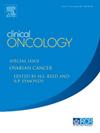择期颈部放疗与头颈部放化疗患者严重淋巴细胞减少症的关系
IF 3
3区 医学
Q2 ONCOLOGY
引用次数: 0
摘要
淋巴细胞减少症是头颈部放疗的并发症,但其具体原因尚不清楚。我们分析了在头颈部鳞状细胞癌(HNSCC)患者接受放化疗(CRT)治疗时,选择性淋巴结照射(ENI)的程度与严重淋巴细胞减少(SL, 4级)之间的关系。方法:我们纳入了2017年至2021年间在两项前瞻性II期ENI降级试验(INFIELD, INRT-AIR)或标准治疗(SOC) CRT中接受最终CRT治疗的口咽、喉和下咽新发T1-4N0-3M0 HNSCC患者。我们记录了治疗前和治疗后1-2年的绝对淋巴细胞计数。比较各组间SL的差异,并研究颈动脉(CA)和颈椎(CS)剂量、SL、局部区域无进展、无远处转移和总生存期(LRPFS、DMFS、OS)之间的关系。结果共纳入169例患者,分别来自INFIELD (N = 57)、INRT-AIR (N = 61)和SOC (N = 51)。SL发病率随着ENI剂量的增加而增加:INRT-AIR、INFIELD和SOC组分别为1.6%、16%和35% (p <;0.001)。在多因素分析中,较高的对侧CA平均剂量(OR 9.0, 95% CI 1.9-43.7)和CS (OR 5.1, 95% CI 1.04-25.2)与SL相关。Cox回归显示CS剂量与OS (HR 2.96, 95% CI 1.38-6.3)和DMFS (HR 2.72, 95% CI 1.34-5.51)之间存在独立关系。结论:seni降级导致SL显著降低,我们发现了这种毒性的新预测因子。缓解RT诱导的SL可能在RT与免疫治疗的最终联合中发挥作用。本文章由计算机程序翻译,如有差异,请以英文原文为准。
Relationship Between Elective Neck Irradiation and Severe Lymphopenia in Patients Treated With Head and Neck Chemoradiotherapy
Introduction
Lymphopenia is a complication of head and neck radiotherapy, but its specific drivers are not well understood. We analyzed relationships between the extent of elective nodal irradiation (ENI) and severe lymphopenia (SL, grade 4) in patients treated with chemoradiotherapy (CRT) for head and neck squamous-cell carcinoma (HNSCC).
Methods
We included patients with new T1-4N0-3M0 HNSCC of the oropharynx, larynx, and hypopharynx who were treated with definitive CRT between 2017 and 2021 on either two prospective phase II ENI de-escalation trials (INFIELD, INRT-AIR) or with standard-of-care (SOC) CRT. We recorded absolute lymphocyte count before and up to 1–2 years after treatment. Differences in SL were compared between cohorts, and relationships between the carotid artery (CA) and cervical spine (CS) dose, SL, and locoregional progression-free, distant metastasis-free, and overall survival (LRPFS, DMFS, OS) were investigated.
Results
A total of 169 patients from INFIELD (N = 57), INRT-AIR (N = 61), and SOC (N = 51) were included. The SL incidence increased with increasing ENI dose: 1.6%, 16% and 35% in the INRT-AIR, INFIELD and SOC cohorts, respectively (p < 0.001). On multivariate analysis, higher mean dose to the contralateral CA (OR 9.0, 95% CI 1.9–43.7) and CS (OR 5.1, 95% CI 1.04–25.2) was associated with SL. Cox regression showed independent relationships between CS dose and OS (HR 2.96, 95% CI 1.38–6.3) and DMFS (HR 2.72, 95% CI 1.34–5.51).
Conclusions
ENI de-escalation resulted in significantly less SL, and we identified novel predictors of this toxicity. Mitigating RT-induced SL may play a role in combining RT with immunotherapy in the definitive setting.
求助全文
通过发布文献求助,成功后即可免费获取论文全文。
去求助
来源期刊

Clinical oncology
医学-肿瘤学
CiteScore
5.20
自引率
8.80%
发文量
332
审稿时长
40 days
期刊介绍:
Clinical Oncology is an International cancer journal covering all aspects of the clinical management of cancer patients, reflecting a multidisciplinary approach to therapy. Papers, editorials and reviews are published on all types of malignant disease embracing, pathology, diagnosis and treatment, including radiotherapy, chemotherapy, surgery, combined modality treatment and palliative care. Research and review papers covering epidemiology, radiobiology, radiation physics, tumour biology, and immunology are also published, together with letters to the editor, case reports and book reviews.
 求助内容:
求助内容: 应助结果提醒方式:
应助结果提醒方式:


